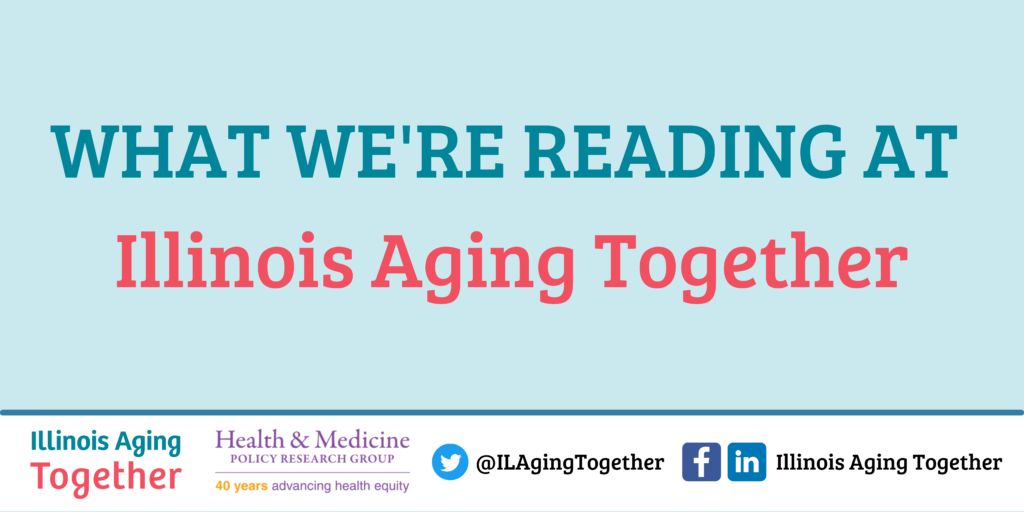
What We’re Reading at the Center for Long-Term Care Reform and Illinois Aging Together
Health & Medicine Policy Research Group’s Center for Long-term Care Reform and Illinois Aging Together campaign are dedicated to advancing policies and structures that improve the conditions in which Illinoisans live, work, play, and age across the life course. Through our work, it is crucial for us to stay abreast of current events, developments, and stories in the aging and health sectors–and beyond.

Below are some of the recent articles that we found most pertinent to our work:
Why your local library may be hiring a social worker (Darian Benson, NPR)
“For years, libraries have been a place people turn to for information to help them solve problems. But the challenges patrons are dealing with are increasingly beyond the scope of what most librarians are trained to handle — and that’s where social workers can fill in the gaps.”
National Population Projections: 2020, 2030, 2040 (University of Virginia)
“The 1990’s were a period of high immigration, accompanied by births in these young immigrant families, which meant the population had a younger age-profile. However, over time, with declining birth rates, reduced immigration, and the large baby-boomer cohort growing older, the overall population’s age distribution is bound to reflect this aging effect.”
Every 8 Seconds, an American turns 65. How Do We Care for Everyone? (Ezra Klein Show and The New York Times ft. guest speaker Ai-jen Poo)
The podcast covers the economic potential of a public investment in child care, elder care, and paid family leave.
Social Isolation and Loneliness: Impacts on Health and Approaches to Prevention for the Fairfax Community (The Partnership for a Healthier Fairfax Behavioral Health Team)
“Social isolation and loneliness (SIL) is a fairly common experience for people of all ages. Over the last few years, research has clarified that SIL can have dramatic effects on physical and behavioral health. We have also identified who is typically at the greatest risk for experiencing SIL. People with physical and/or mental health issues, people who lack social supports, people experiencing transitions in their lives, and members of marginalized groups such as recent immigrants and LGBTQ people are all more likely to experience SIL than their peers.”
As We Live Longer, How Should Life Change? There Is a Blueprint. (Corinne Purtill, The New York Times)
Most children born today in developed countries can very reasonably assume they will live to 100 years old. However, the longevity we expect now has grown much faster than the institutions and industries meant to support us as we live and age. “The New Map of Life” recommends spacing out education, among other common life benchmarks, to accommodate the changing social, financial, and lifestyle needs of each new generation.
Treating Chronic Pain Takes a Team. I Had to Build My Own (Kari Cobham, The New York Times)
The author details their experience living with and seeking treatment for their chronic illness and pain. They encourage readers to be their own advocate, build a care team, and keep planning for their future.
We need to campaign against ageism (Marc Blesoff, Wednesday Journal of Oak Park and River Forest)
Ageism is socially and institutionally pervasive, impacting quality of life in a number of ways. New research has found that positive feelings about aging can mitigate a number of physical health issues, including dementia symptoms, and shorten recovery time after adverse health events. This makes a compelling case for considering and addressing ageism as a public health issue.
What you need to know about Aduhelm (Kathleen Cameron, National Council on Aging)
“In the summer of 2021, the U.S. Food and Drug Administration granted historic accelerated approval for Alzheimer’s treatment, Aduhelm, designed to slow cognitive decline for persons with the disease. The clinical trials for the new treatment showed that it is best used in persons with early-stage Alzheimer’s disease. The drug is not a cure for Alzheimer’s disease. On January 11, 2022, the Centers for Medicare and Medicaid Services (CMS) proposed that this medication would be covered by Medicare only for patients enrolled in qualifying clinical studies.”
How Betty White transcended Hollywood Ageism (Renee Morad, MSNBC)
“Beyond her stardom, White also left behind a bold message for women around the world. By leading through example, she taught women that instead of hiding or fighting their age, they should embrace it wholeheartedly and use their life experiences to their advantage.”
Supporting and Sustaining the Home Care Workforce to Meet the Growing Need for Long-Term Care (American Public Health Association)
“The rapidly aging U.S. population, increased costs for long-term institutional care, and individual preferences for remaining at home have made home care services one of the fastest growing industries in the United States. Home care workers are paid caregivers who provide essential medical and nonmedical assistance to older or disabled clients, enabling them to remain in their homes. These services vary by type of worker and may include simple procedures, personal care services or routine housekeeping. Home care work is typically low paid, isolated, stressful, and hazardous.”

